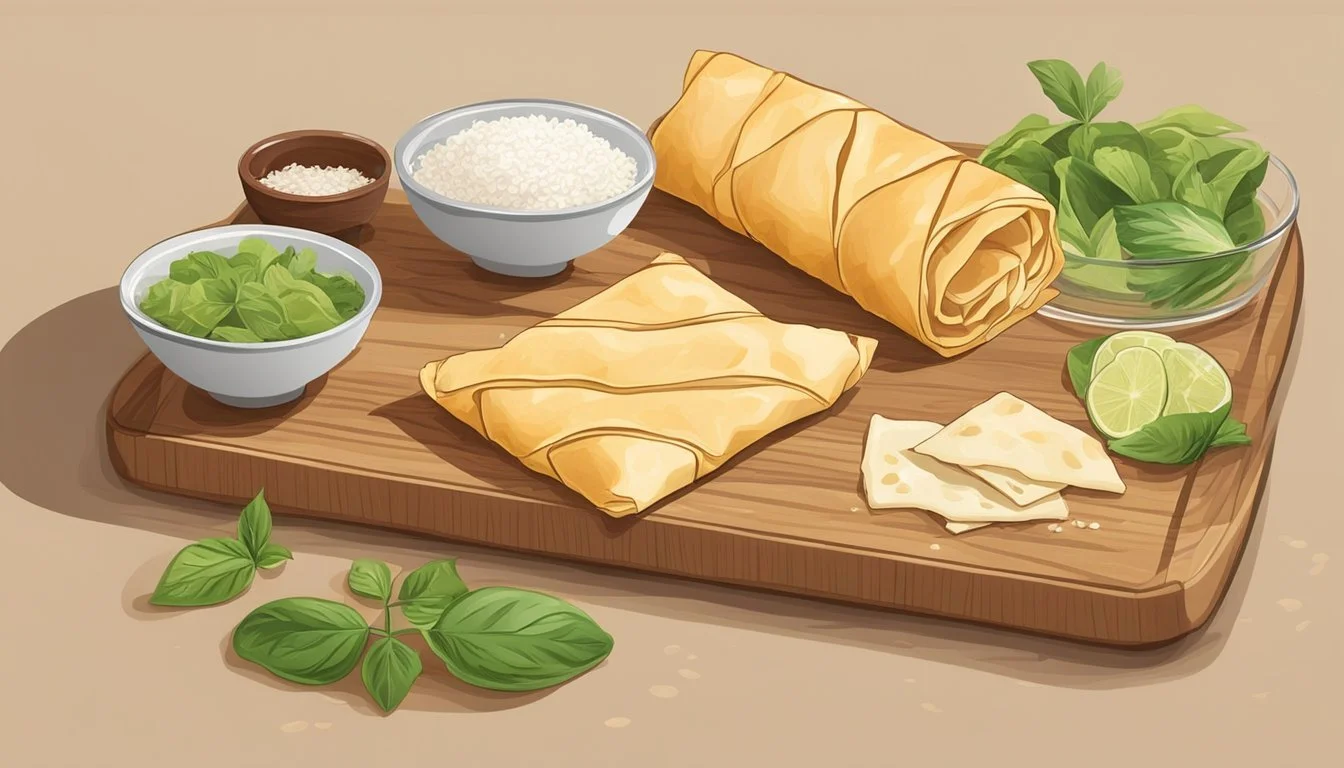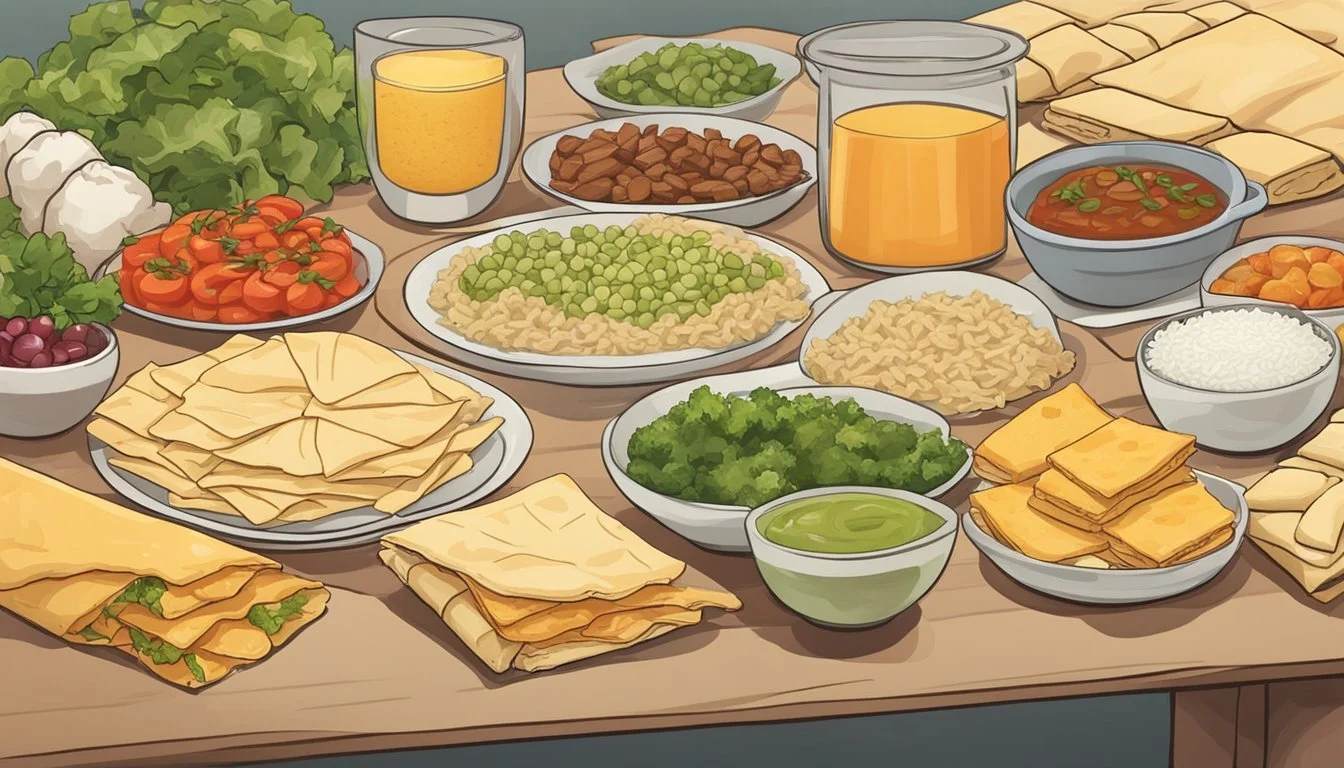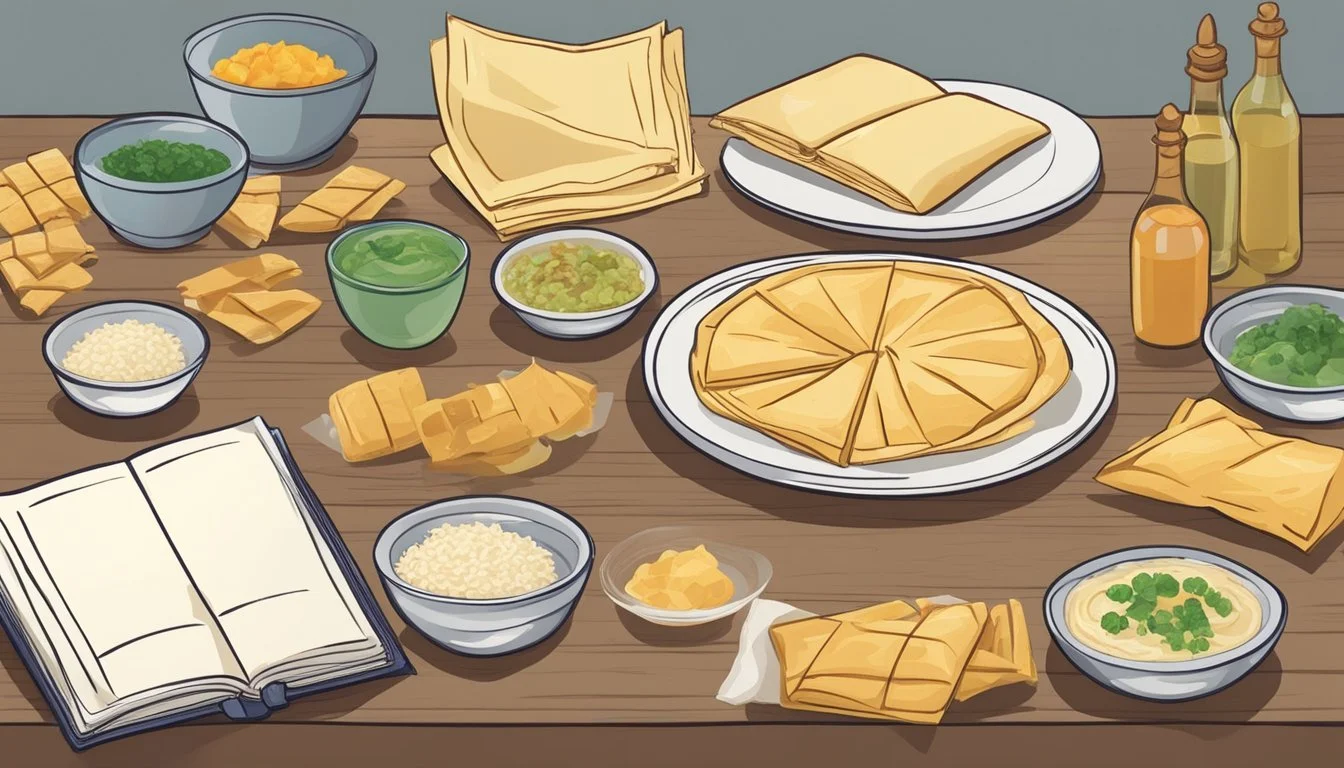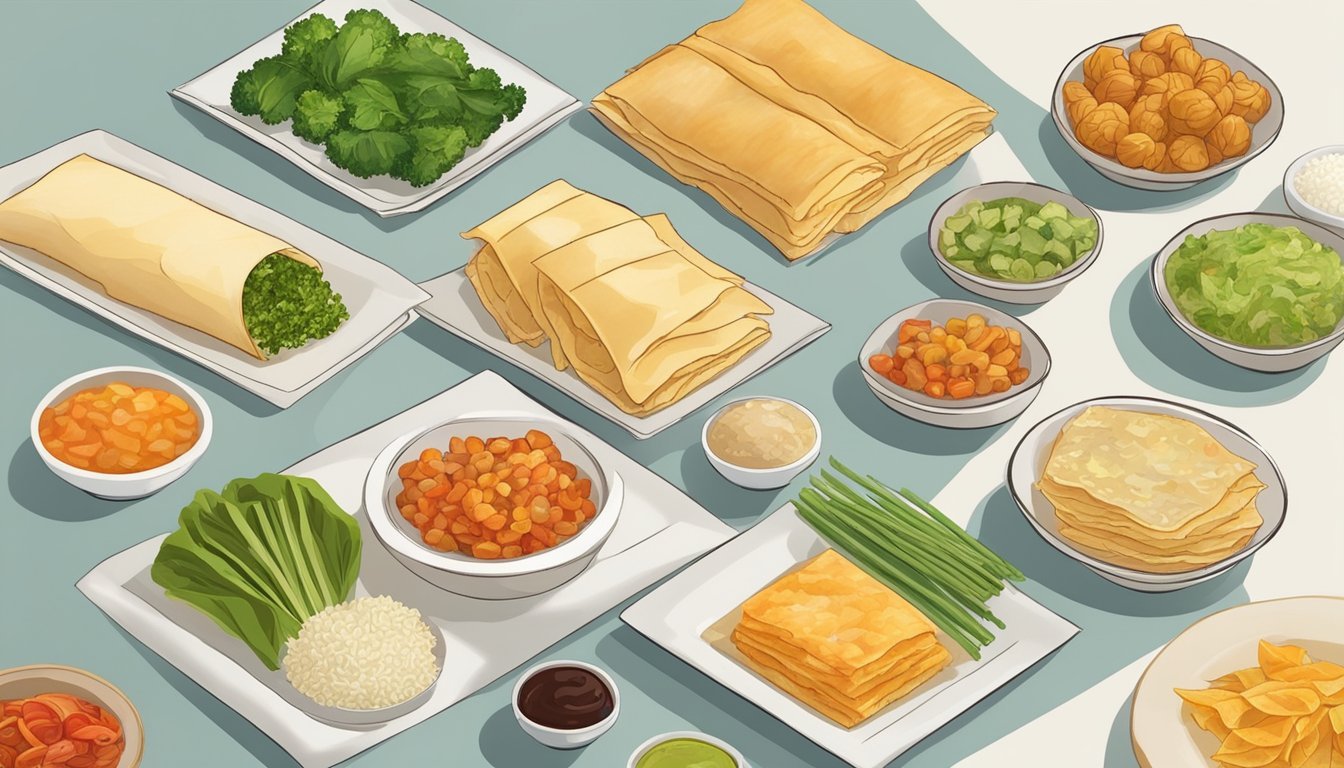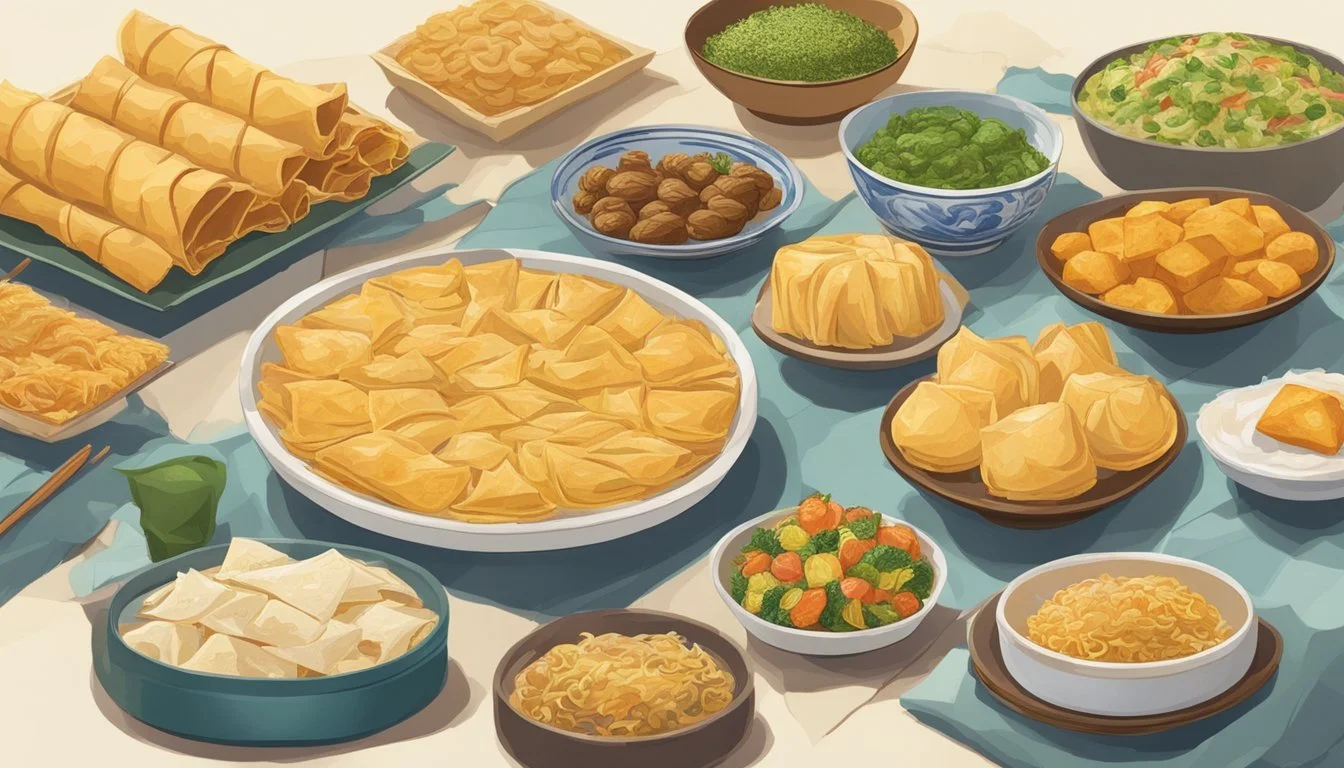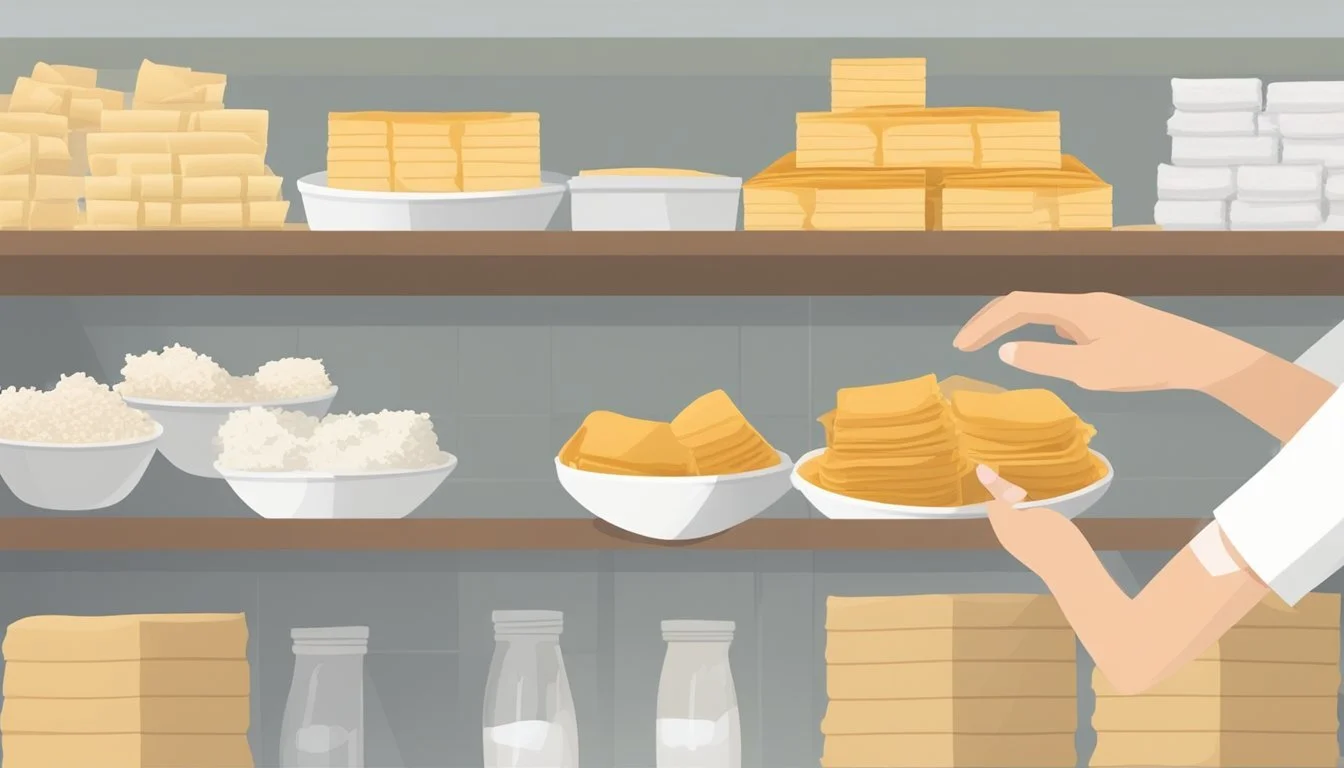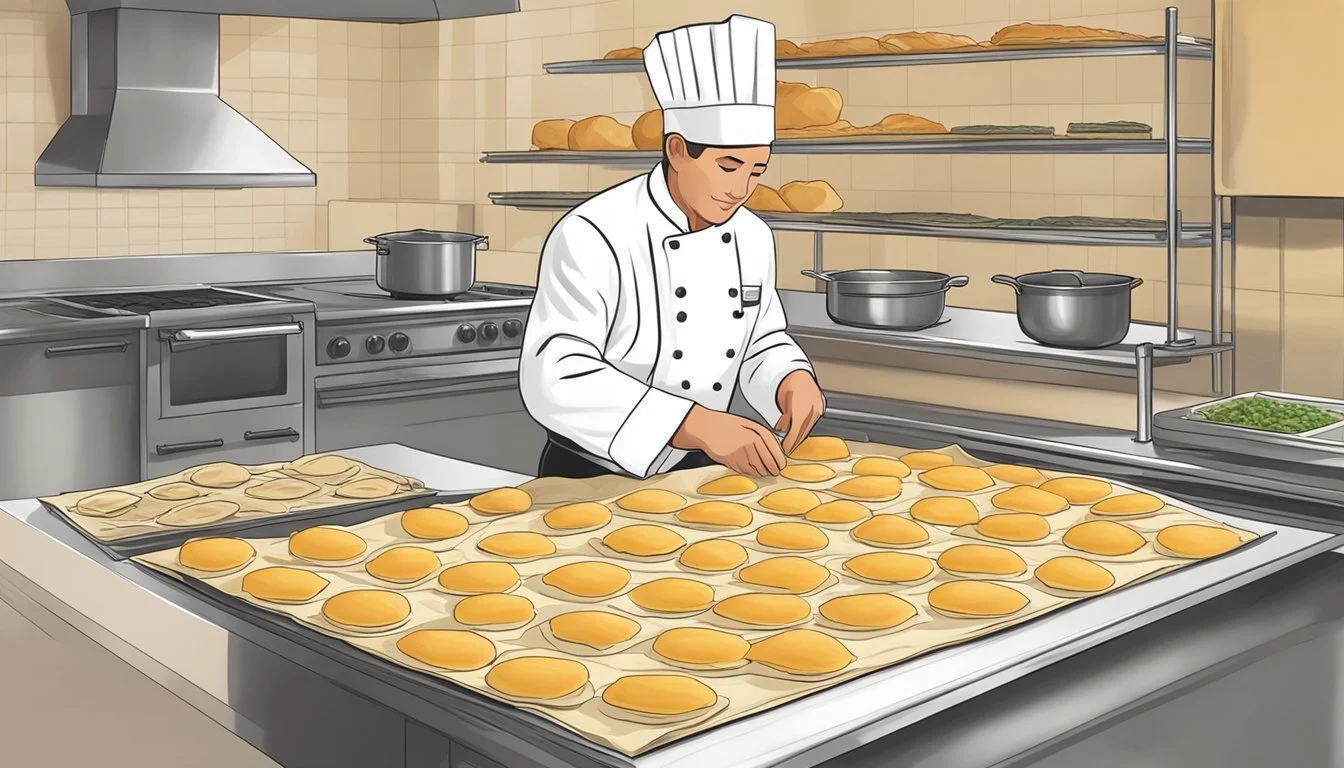Phyllo Substitutes
Top Alternatives for Your Recipes
Phyllo dough is a staple ingredient in Middle Eastern and Mediterranean cuisines, renowned for its paper-thin sheets that, when baked, deliver a delicate flakiness to dishes. Traditionally used in baklava, spanakopita, and a multitude of savory appetizers and desserts, phyllo's versatility allows cooks to create texture-rich layers that are both crisp and tender. Mastering phyllo dough can be challenging due to its delicate nature; the thin dough can dry out and tear easily, requiring careful handling and often a generous application of butter or oil between layers.
In the realm of baking, the quest for suitable phyllo dough substitutes arises when chefs encounter issues with availability, dietary restrictions, or simply the desire to explore different textures and flavors. Among the alternatives, puff pastry stands out as a robust option. It offers a similar light and airy texture with considerably less fragility in preparation. Made with flour, water, butter, and salt, puff pastry's convenience is matched by its buttery layers which puff up during baking to create a rich, flaky product. This makes it an excellent choice for both sweet and savory recipes that would traditionally call for phyllo.
Other phyllo substitutes include various types of pastry dough, each bringing its unique characteristics to the table. For instance, a standard pie crust might be used in recipes that call for a more structural base, such as savory pies, while lighter, more delicate pastries could be represented by puff pastry. The selection of an alternative often depends on the final texture desired and the specific demands of the recipe at hand. Each substitute carries the potential to impart a different quality to the dish, providing bakers and cooks with a palette of options to achieve their culinary objectives.
Understanding Phyllo Dough
Phyllo dough is an essential component in various baked goods, known for its thin, flaky layers. Mastery of phyllo can elevate one's baking repertoire, offering a lighter texture compared to other pastries.
Phyllo Dough Basics
Phyllo dough, a staple in Mediterranean and Middle Eastern cuisine, is a delicate pastry made primarily from flour, water, and a small amount of oil or vinegar. Unlike puff pastry, it does not contain high amounts of butter or fat. The crafting of phyllo dough involves rolling out the dough into paper-thin sheets before baking, a process requiring skill and patience. When baked, the dough becomes characteristically flaky and crisp.
Ingredients:
Flour
Water
Oil or Vinegar
(Sometimes) Salt
Texture: Crisp and flaky
Baking Uses:
Desserts (e.g., baklava)
Appetizers (e.g., spanakopita)
Main courses
Preparation:
Rolled into thin sheets
Layered during preparation
Brushed with oil or melted butter before baking
Health and Nutritional Aspects
Phyllo dough might be considered a healthier alternative to other forms of pastry due to its lower fat content. It usually does not contain butter in its mixture, allowing it to have fewer calories and cholesterol. This aspect makes it a preferable choice for those who are mindful of their fat intake without compromising on the quality and integrity of the dishes they prepare.
Nutritional Considerations:
Calories: Lower than puff pastry
Fat: Minimal amounts, primarily from oil
Cholesterol: Generally lower compared to butter-rich pastries
Healthier Baking:
Phyllo dough can be part of a balanced diet.
Its light texture means less use of high-calorie fillings or spreads.
When utilizing phyllo in cooking and baking, one should handle it with care, as the thin sheets can dry out quickly. Cooks often cover the sheets with a damp towel during preparation to maintain moisture. Each layer, when brushed with a healthy oil option and baked, contributes to the final product's unique texture while being a mindful addition to a health-conscious diet.
Types of Phyllo Substitutes
When a recipe calls for phyllo dough, and it's not available, several substitutes can offer a similar texture and flavor. Whether seeking gluten-free options or more accessible alternatives, the following substitutes are worth considering.
Puff Pastry
Puff pastry is a versatile substitute that comprises flour, water, butter, and salt. It's available in the frozen section of most grocery stores and, once thawed, can be rolled out into thin sheets. Its buttery flakiness closely resembles that of phyllo dough and is ideal for both savory applications, such as meat pies, and sweet confections, including turnovers.
Homemade Alternatives
For those who prefer homemade options, creating a homemade phyllo dough can be a rewarding albeit time-intensive process. This involves mixing flour and water into a dough, dividing it, and then rolling each piece into a thin, almost translucent layer. Additions of cornstarch or oil can assist in achieving the desired texture. Alternatively, combining common pastry dough ingredients and rolling them thinly mimics phyllo's delicate layers.
Gluten-Free Options
Individuals with gluten sensitivities can opt for gluten-free alternatives such as rice paper or gluten-free pastry sheets, ensuring that the product's texture and flavor closely align with that of traditional phyllo dough. Adjustments in moisture content and baking time may be required to achieve the characteristic crispiness.
Commercial Substitutes
Commercially, there are specific substitutes for phyllo dough tailored for convenience or dietary restrictions. These include spring roll wrappers, which are thinner than phyllo but offer a similar crispiness. Filo or fillo, which is essentially a variant spelling of phyllo, may also be found as an alternative under different brand names, designed to provide a similar texture and layering when used in various recipes.
Substitute Ingredients
When seeking alternatives for phyllo dough, the focus is on key components that impact the dough's texture and layering effect. Substitutions in this context break down into fats, binders, and flour alternatives, each playing a crucial role in achieving a similar delicate, flaky result.
Fats and Oils
Fats are instrumental in creating the flaky layers that phyllo dough is known for. The following are common substitutes:
Butter: A classic choice, imparting rich flavor and aiding in layer separation.
Oil: Particularly neutral oils like canola or vegetable oil provide moisture without altering taste.
Binders and Leaveners
Binders and leaveners contribute to the structure and rise of doughs. Here, we focus on choices that complement phyllo dough substitutes:
Eggs: Serve as a binder, adding richness and color to the dough.
Baking Powder: A common leavening agent, used sparingly can assist in slight puffing of dough layers.
Flour Alternatives
Flour forms the base of phyllo dough, and alternatives must mimic its properties closely:
Wheat Flour: The standard choice, offering gluten for elasticity and structure.
Cornstarch: Often mixed with flour to reduce gluten content, yielding a tender texture.
By carefully selecting and combining these ingredients, cooks can create a suitable substitute that comes close to the texture and versatility of traditional phyllo dough.
Applications and Recipes
Phyllo dough's versatility shines through in an array of sweet and savory dishes, each benefiting from its flaky texture. It is essential in recipes that aim for a light, crisp exterior, whether incorporating a medley of vegetables, spinach, meat, or a sweet filling.
Desserts and Sweet Pastries
Desserts crafted with phyllo dough are celebrated for their delicate layers and satisfying crunch. Spanakopita takes on a sweet twist, leaving behind its traditional savory blend of spinach and feta. Baklava, a classic Greek dessert, exemplifies the artful use of phyllo as it layers nuts and sweet syrup between the dough's paper-thin sheets. Phyllo can also transform into elegant tarts and turnovers, holding fruits or sweetened cheese.
Baklava: Layer chopped nuts, sugar, and spices between buttered phyllo sheets, top with syrup.
Tarts: Top phyllo sheets with cream cheese and fruit, bake until golden.
Savory Dishes and Appetizers
In savory applications, the light dough encases ingredients ranging from simple cheeses to complex, spiced meat mixtures. Spanakopita reclaims its place as a savory staple, with phyllo enveloping a hearty spinach and feta filling. Samosas, ordinarily wrapped in a thicker pastry, can be reinvented with phyllo for a lighter fare. Small bites such as appetizers and quiches (What wine goes well with quiche?) gain a refined edge when phyllo replaces denser crusts.
Spanakopita: Fill buttered phyllo with a mixture of spinach, feta, and herbs; bake until crisp.
Quiches: Press phyllo into tart pans, fill with egg and vegetables or meat, and bake.
Regional Cuisine Varieties
Phyllo is deeply rooted in Mediterranean and Greek dishes, but it seamlessly adapts to regional variations across the globe. It wraps vegetables and meat in Mediterranean cuisines, showcasing the local flavors wrapped in a crispy, flaky shell. The dough's pliability and neutral taste also make it an ideal candidate for crafting various Mediterranean and Greek meat pies, adjusting spices and fillings to geographical tastes.
Mediterranean Meat Pie: Season ground meat with regional herbs and spices, layer inside phyllo, then bake.
Greek Dishes: Adapt classic Greek fillings to phyllo, from spinach to minced lamb, often accompanied by tzatziki dip.
Working with Phyllo Substitutes
Working effectively with phyllo dough substitutes requires attention to detail in handling and preparation, cooking techniques, and storage methods. These substitutes play a crucial role in achieving a similar texture and crispiness to that of traditional phyllo dough.
Handling and Preparation
Phyllo dough substitutes, like puff pastry or strudel dough, often come frozen and need to be thawed properly before use. They should be brought to room temperature gradually to prevent the dough from becoming too soft or sticky. Homemade dough takes careful measurement and a gentle touch to maintain a consistent texture. It is advisable to:
Flatten: Roll out the dough evenly to the desired thickness, being attentive not to tear or overwork the dough as it can lose its delicate structure.
Layer: Brush each layer lightly with olive oil or melted butter, which helps create a flaky, crispy texture once baked.
Cooking Techniques
Adjusting the cooking technique is necessary when using substitutes to achieve the desired flakiness and color. Here, laminated dough like puff pastry may require different baking temperatures compared to traditional phyllo:
Bake: Most substitutes should be baked until they sport a golden hue and crispy texture. This often occurs at a temperature ranging from 350°F (175°C) to 400°F (200°C).
Monitor: Keep a close eye on the oven as substitutes can brown quickly and may need to be covered with foil to prevent burning.
Storage and Freezing
Phyllo dough substitutes can be more forgiving when it comes to long-term storage. To ensure the quality remains high:
Refrigerating: Store unused portions of dough in the refrigerator wrapped in plastic for a few days.
Freezing: To freeze, wrap the dough tightly in plastic and then place in a freezer bag. Use within a few months for optimal quality.
Remember, thawing should be done in the refrigerator overnight to avoid any textural changes.
When handled properly, phyllo dough substitutes can be seamlessly incorporated into recipes, maintaining texture and taste that closely mimics the original.
Healthier Alternatives
When opting for healthier alternatives to traditional phyllo dough, the goal is to reduce caloric content, minimize cholesterol levels, and boost the nutrition profile using thoughtful ingredient swaps and preparation methods.
Reducing Caloric Content
Reducing calories in phyllo dough alternatives can be achieved by selecting lower-calorie ingredients. Rice paper sheets are an excellent option with a lower calorie count. They provide a light and crisp texture similar to phyllo dough when baked. The calorie content of rice paper is notably less compared to traditional phyllo, primarily because they contain no added fats.
Rice paper sheet: 30-40 calories per sheet (varies by brand)
To further reduce calories, individuals may use herbs and spices as flavor enhancers instead of high-calorie fillings like cheese or creams. This technique allows for a flavorful dish without the additional calories.
Lowering Cholesterol
Choosing a phyllo substitute with no cholesterol entails incorporating plant-based options such as olive oil. Olive oil can be brushed onto layers of a chosen substitute for a heart-healthy fat, as opposed to butter, which contains cholesterol. Another choice for lowering cholesterol is using fillings made with nutritional yeast instead of cheese.
Comparison of Cholesterol Content:
Butter: Approximately 30mg of cholesterol per tablespoon
Olive oil: 0mg cholesterol
Incorporating Nutrients
To enrich the nutritional content, substitutes like whole grain or seed-based doughs that incorporate grains like quinoa or chia can add fiber, minerals, and vitamins. These alternatives not only help in managing blood sugar levels but also enhance the overall nutritional value of the meal. Using whole grain options can provide a more nutrient-dense choice, contributing to a feeling of fullness and improved digestive health.
Here is a list highlighting some nutritional components of whole grain and seed-based doughs:
Fiber: Crucial for digestive health
Protein: Essential for building and repairing tissues
Minerals: Includes iron, magnesium, and zinc for various bodily functions
Cultural Significance of Phyllo
Phyllo, also known as filo, is a versatile dough pivotal to many traditional dishes, embodying a history of culinary exchange and adaptation.
Mediterranean Cuisine
In Mediterranean cuisine, phyllo is the cornerstone of numerous savory and sweet dishes. Greek cuisine celebrates phyllo in the iconic spanakopita, a spinach and feta pie that exemplifies the balance of flaky pastry with rich fillings. The use of phyllo extends to the celebrated dessert baklava, with layers of the dough, nuts, and syrup showcasing a mastery of textural contrast.
Greek Cuisine: Spanakopita, Baklava
Common Ingredients: Olive oil, Spinach, Feta cheese, Nuts, Syrup
Asian Traditions
Phyllo's thin, paper-like quality has counterparts in Asian traditions. While not directly related to Asian rice papers or spring roll wrappers, the concept of wrapping a filling in a thin dough is a common culinary technique. This affirms phyllo's place within a global context of similar dough-based foods.
Similar Concepts in Asia: Spring rolls, Rice Paper
Typical Uses: Wrapping fillings, both savory and sweet
Adaptation in Global Dishes
The adaptability of phyllo has seen it incorporated into dishes well beyond its Mediterranean and Middle Eastern roots. Chefs worldwide leverage its flaky layers to create fusion dishes, merging traditional phyllo applications with local ingredients and tastes.
Global Influence: Fusion dishes, Local adaptations
Versatility: Sweet and savory applications, Cross-cultural appeal
Choosing the Right Substitute
When looking for a substitute for phyllo dough, one must carefully consider the factors such as texture, taste, cost, and availability to ensure the success of the dish.
Factors to Consider
Selecting an appropriate alternative for phyllo dough relies heavily on the specific requirements of the recipe you're making. Essential attributes to evaluate include the recipe type (sweet or savory), the desired flakiness or crispness, and how the substitute will interact with other ingredients.
Taste and Texture Matching
An ideal substitute should closely mimic the delicate, flaky texture of phyllo dough. Texture-wise, puff pastry is the most common replacement due to its similar layered structure. Although thicker, it provides a good balance between lightness and stability. For a closer texture resemblance, especially in traditional European dishes, strudel dough may be used. It offers a thin, elastic quality akin to phyllo but with a slightly different, often more doughy, taste profile.
Taste Comparison:
Puff Pastry: Buttery and rich
Strudel Dough: Neutral, slightly doughy
Texture Comparison:
Puff Pastry: Flaky and layered
Strudel Dough: Thin and elastic
Cost and Availability
Most alternatives to phyllo dough are readily available at local grocery stores. Puff pastry is usually less expensive and found in the freezer section. Strudel dough, while not as common, may also be found in stores that carry a broader selection of international products. In addition to accessibility, one must consider the price point, as certain substitutes—especially those that are pre-made and imported—can be more expensive.
Availability:
Puff Pastry: Commonly found
Strudel Dough: Less common, specialty shops
Cost:
Puff Pastry: Generally less expensive
Strudel Dough: Potentially more expensive due to import costs
Specialty Substitutes
In the realm of phyllo dough alternatives, certain specialty substitutes can hold their unique textures and flavors while offering versatility for various dietary restrictions and cuisines. They cater to vegans, various ethnic cooking traditions, or those looking for quick, ready-made options.
Vegan Options
For those adhering to a vegan diet, rice paper stands out as a fitting alternative to phyllo dough. Typically used in Asian cuisine, these thin sheets derived from rice starch are gluten-free and have an almost translucent appearance when cooked. They work well for making fresh spring rolls or baked vegan pastries.
Vegan Substitute Characteristics Use-case Examples Rice Paper Gluten-free, translucent, adaptable Fresh spring rolls, baked vegan desserts Vegan Filo Dough Free from animal products, flaky Plant-based spanakopita, baklava
Ethnic Varieties
Ethnic varieties of phyllo substitute encompass spring roll wrappers and wonton wrappers, which are staples in Asian cookery. Spring roll wrappers are similar to rice paper but generally thicker, offering a satisfying crunch when fried. Wonton wrappers are square dough sheets primarily used for dumplings but can also be utilized for a variety of appetizers or desserts.
Ethnic Substitute Characteristics Use-case Examples Spring Roll Wrappers Thicker than rice paper, crispy when fried Fried spring rolls, samosas Wonton Wrappers Square-shaped, versatile Dumplings, crisp pastry cups
Ready-Made Solutions
Ready-made alternatives like store-bought vegan filo dough provide convenience without compromising on quality. They can be used straight from the package, eliminating the need for extensive preparation. Ensure that the chosen product is suitably rolled out and brushed with vegan butter or oil for crispiness and flavor.
Ready-Made Substitute Characteristics Use-case Examples Vegan Filo Dough Pre-prepared, time-saver Vegan strudels, pies, tarts Pre-Rolled Pastry Sheets Easily accessible, versatile Quick turnovers, appetizers
These specialty substitutes offer diverse options for those looking to replace traditional phyllo dough, catering to a range of specific dietary needs and cultural palate preferences.
DIY Phyllo Dough Making
Crafting phyllo dough at home can yield an incredibly fresh and elastic pastry ideal for a variety of dishes. This DIY approach allows one to imbue a personal touch into the baking process, ensuring the quality of ingredients and the satisfaction of creating something from scratch.
Creating Homemade Filo
The foundation for homemade phyllo dough is a well-tested recipe that calls for basic ingredients: all-purpose flour, olive oil, fine salt, acid in the form of lemon juice or white wine vinegar, and warm water. The recipe typically starts by mixing 2 cups of all-purpose flour with a ½ teaspoon of fine salt. Incorporating 4-5 teaspoons of olive oil and 2 teaspoons of an acid helps create the needed crispness. Gradually adding about ¾ cup of warm water forms a workable dough.
Alternative Ingredients
Making phyllo dough can adapt to the availability of ingredients. While traditional recipes focus on simple, readily available ingredients, substitutions can be made to accommodate dietary restrictions or personal preferences. For example, gluten-free flour blends may replace all-purpose flour for those with sensitivities.
Techniques and Tips
Proper technique is crucial in achieving the characteristic thin layers of homemade phyllo dough. It begins with kneading the dough until it's smooth and elastic, which might take up to 10 minutes. Resting the dough is a pivotal step that facilitates the rolling process. Using a rolling pin, roll the dough out as thinly as possible, working with a dusting of flour to prevent sticking. Even and consistent rolling is essential to achieve a uniform thickness across the dough.
It is important to cover the layers of dough with a damp cloth during assembly to keep them from drying out. The thin layers are what will provide the desirable flaky texture of the finished product. With patience and precision, one can master the art of homemade phyllo dough crafting.


